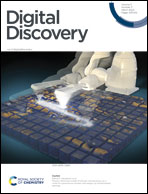A human-in-the-loop approach for visual clustering of overlapping materials science data†
Abstract
Data-to-knowledge has started to reveal significant promise in materials science. Still, some classes of materials, such as Metal–Organic Frameworks (MOFs), possess multi-dimensional interrelated physicochemical properties that pose challenges in using data clustering methods. We considered an in-house generated database of MOFs consisting of geometrical (pore size and dimensions), chemical (atomic charge of the framework), and adsorption properties (CO2 uptake, heat of adsorption) to evaluate the challenges and limitations of various clustering techniques and propose a solution based on visual clustering. As a starting step, we examined data via principal component analysis (PCA) to understand the interrelationships among a set of dimensions without prior knowledge. This dimensionality reduction method was unsuccessful in visually discovering clusters of MOFs. Then, we tested two combinations of data projection and clustering methods: T-distributed stochastic neighbour embedding (t-SNE) and Density-Based Spatial Clustering of Applications with Noise (DBSCAN) on the original dimension input data (t-SNE//DBSCAN), and Hierarchical Density-Based Spatial Clustering of Applications with Noise (HDBSCAN) clustering the 2D embedding data obtained from Uniform Manifold Approximation and Projection (UMAP) (UMAP → HDBSCAN). Both the t-SNE//DBSCAN and UMAP → HDBSCAN pipelines are found to have overlapped clusters, which lack reproducibility and are parameter-sensitive. In contrast, we relied on a Gaussian mixture model (GMM) that uses the eigenvalue decomposition discriminant analysis (EDDA) method. This method is stable and not strongly dependent on the prior definition of the hyperparameters. We propose a novel interactive divide-and-conquer approach, the combination of GMM-EDDA and a form of linear discriminant analysis to enable visual split or merge decisions for each pair of Gaussian clusters. The end-user engages in the clustering process using trustworthy visualization where clusters appear as separated only if they are also well separated in the data space. Further, the identified meta-clusters were characterized using correlation heatmaps and violin plots of their distribution along each data dimension. Our methodology paves the way to address the clustering and data visualization challenges of highly overlapped and correlated databases.

- This article is part of the themed collection: Accelerate Conference 2022


 Please wait while we load your content...
Please wait while we load your content...